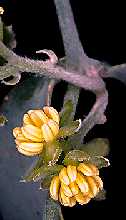View crop
View crop Data sheet EcoPortSimmondsia chinensis
 |
|
| Notes |
|---|
| DESCRIPTION: An evergreen bushy shrub or small tree reaching as high as 3-4.5 m on well-watered sites. USES: Jojoba produces oil and wax from its fruit capsules and brown nuts. The oil is used in cosmetics, drugs, plastics, waxes, and leather. The wax is used as a lubricant in linoleum, detergents, pharmaceutical products, polishes, and carbon paper. The flibert-flavored nuts are cured and eaten from the shell. The seed meal is a source of concentrated vegetable proteins. The plant also make attractive clipped hedges and slope covers. KILLING T.: Seedlings may tolerate -5°C, and older plants -9°C. GROWING PERIOD: Perennial. It begins to bear after 3-5 years and thereafter fruit annually. The plant come into full bearing in 7-8 or 10-12 years, and bears for 100-200 years. Fruits mature 90-180 days after fertilization. COMMON NAMES: Jojoba, Goat-nut, Jojowi, Bucknut, Coffee nut, Pig nut, Lemon leaf. FURTHER INF.: Scientific synonyms: S. californica, S. pabulosa. Jojoba thrives best in areas of low humidity and it is drought hardy. Wind affects the shape and habit of growth and it often only reach a height of 0.6-0.9 m because of the harshness of its environment. Jojoba can be grown from sea level or from 300 to 1500 m in elevation. The origin of jojoba is obscure but the present wild distribution is limited to northern Mexico and southwestern United States between 23 and 35°N. A temperature drop to around 15°C for a period of about 2 months is necessary to break the dormancy of the flower buds. Seed yields can vary between 0.5-15 kg per tree. Mentioned as a useful agroforestry species. Average yield obtained from planted stands of jojoba is 2.25 t/ha, or about 1.5 kg/plant annually. | Sources |
| Weiss E 1983 pp 507-527 [KTMP, TEMP, RAIN, PHO, DRA, TEXT, DEP, PH, SAL, FER] Roecklein J 1987 pp 114 [USE, RAIN, DRA] Duke J 1975 pp 27 [PH, RAIN, TEMP] Sims D (pers. comm.) Nair P 1980 pp 320-321 [RAIN, TEMP, TEXT, DRA, SAL, USE] Rehm S 1991 pp 395 [RAIN, TEMP, USE] Ritchie G 1979 pp 177 National AS 1975 pp 105 INSPIRE species 161 [RAIN, TEMP, TEXT, PH, DRA, SAL, LIG, USE] Webb D 1984 pp 244 [RAIN, TEMP, TEXT, PH, DRA, SAL, LIG, USE] |